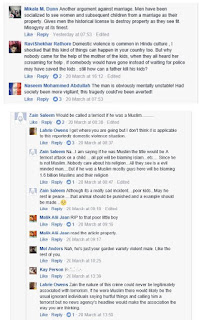Negotiation
Audiences can
negotiate media products in any way that they wish, and different audiences may have completely different interpretations to one another. For example, depending on the audience the TV programme
Family Guy can be negotiated in the following ways:
- A hilarious, disgusting comedy
- A deep satire of American culture
- A hilarious show about a dog and a baby, with lots of boring politics and gross jokes that they just ignore
- A particularly upsetting, and completely unfunny animated sitcom
- Too boring to even form an opinion about
While many producers rely on a multitude of negotiated readings, it is essential to try and tie an audience into one particular way of thinking. This process is carried out by producers, and is called anchorage
Anchorage
Where the meaning of a media text is fixed or stabilised by a caption, shot type, costume or so on
Often, the elements of a media product, for example pictures in a newspaper, a camera angle in a TV programme, or a setting in a videogame tell us very little. Without the producer anchoring the image into a particular ideology, an audience could interpret a text in any way they choose.
However, producers often have a point of view that they wish to disseminate to the audience, so they choose to fix a particular meaning. The most pertinent example of anchorage is where meaning is anchored by newspaper captions.
Without a caption or an article, the above image has no context, and it has nothing to anchor it. We might guess that we're looking at a protest, and the
shallow-depth-of-field shot combined with the interesting framing creates an intense image filled with potential human drama, and many themes of conflict. Yet when a caption is added, the
significations of the imagery become more grounded, or
anchored.
Anti-austerity demonstrators descend on Washington
A crowd united through opposition to the government's plans to public sector pay cuts protested en-masse on Saturday...
Liberated citizens cheer on their American benefactors
In a touching scene that has been commonplace since the American liberation of Baghdad, citizens showed a spontaneous display of gratitude to the American soldiers who had toppled the previous regime...
Neo-Nazi demonstrators protest gay marriage
In violent scenes outside of the senate, a small but highly organised group of Neo-Nazi factions from all over America joined forces to protest the recent marriage equality bill...
Deaf protesters in DC demand the right to work
Marginalized and generally silenced within mainstream society, members of the Deaf community stood together at the Deaf Protest in Washington, DC to make their voices heard loud and clear...
In each instance, the
anchorage provided by the caption completely changes the ways in which an audience negotiates and derives meaning from a media text. The real headline is the final one, by the way, and the original story can be read
here.
In many cases, different media producers can utilise the same image, or a very similar image, and anchor it in such a way that fixes a very particular meaning.
Examine these two newspaper front covers from Thursday 8th June 2017, the day of the general election. The first is from The Sun, a right wing tabloid, while the second is from The Morning Star, a left wing tabloid. Make sure you click the images so you can read the sluglines, copy, and so on.
From a point of view of layout, both front covers are actually very similar! Both make explicit use of interpellation in the top right corner, with an explicit, direct mode of address to the audience. The Sun even goes as far as to assume the audience already agree with their demand:
We've had enough of Jezza's rubbish... VOTE TORY
By the inclusive use of the word "we've", and the weighted, highly suggestive use of the word "rubbish", The Sun are less asking the audience to vote for the conservative party that suggesting that not voting for them would be completely illogical.
Both newspapers include a bullet point list: The Morning Star edits and reiterates elements from the labour manifesto. In doing so, several key words anchor the dominant ideology of the text. For example
RENATIONALISE OUR RAILWAYS
makes explicit use of the word "OUR", which here has significations of belonging, community and ownership. It suggests that the reader has the potential to regain something taken from them, or, in Todorovian terms, to restore a disequilibrium in society. The image of labour leader Jeremy Corbyn, positioned immediately to the right and presenting a victorious 'thumbs up' gesture further galvanises this reading.
Finally, the most significant aspect of each front cover is the image of Corbyn himself. While The Morning Star selects a much smaller image of the labour party leader, his confident smile and slightly wonky thumbs up suggests both competence, and an approachable and friendly figure.
The Sun chooses mise-en-scene and crude Photoshop techniques to ridicule Corbyn instead. A large headline implores the reader
DON'T CHUCK BRITAIN IN THE.. COR-BIN
The use of the loose pun "COR-BIN" is an informal mode of address, a childish joke that anchors Corbyn as an idiot. His confused face (not directly addressing the camera as in
The Morning Star) along with the fact he is actually presented in a dustbin further situates him as incompetent, dirty, pathetic and somebody to laugh at.























































